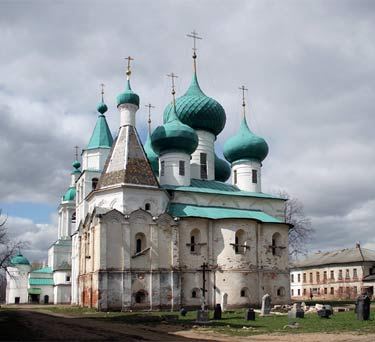

Abraham Monastery (Авраамиев Богоявленский монастырь) was found in the 11th century by Abraham of Rostov near Rostov Kremlin. According to local legends in the ancient times this area had a pagan Slavic temple dedicated to god Veles. Shrine was abandoned, but memory of bloody sacrifices was preserved for generations. After death of Abraham his disciples buried him and kept his staff in the main church of the Abraham Monastery. During military campaign of Ivan the Terrible against Tatars of Kazan Russian tsar paid a visit to the Abraham Monastery during his pilgrimage before the battles. He took the staff of the saint and upon successive defeat of Kazan khans he returned and ordered construction of the Cathedral of the Epiphany in 1553- 55.
The legend about the founding of the monastery is
contained in the Life of Avraamy of Rostov. According to legend, a
stone idol of Veles once stood at this place, which was worshiped by
the ancient inhabitants of these places. It was destroyed thanks to
the Apostle John the Theologian, who appeared here after the prayer
of the hermit Abraham and gave him a rod: with it the idol was
crushed. On the site of the defeated pagan shrine, the hermit built
a temple and founded a monastery.
In historical science, the
question of the time and circumstances of the founding of the
monastery is considered controversial. Evgeny Golubinsky and Arseniy
Kadlubovsky refused to consider Abraham the founder of the monastery
(which was first mentioned in the Laurentian Chronicle under 1261)
and consider him as a church leader of the XIV century (and most
scientists recognize the XV century as the time of writing the
original edition of the life).
The rod of Abraham was kept in
the monastery for a long time. Before going to Kazan, Tsar Ivan the
Terrible made a pilgrimage to the monastery and took the rod of
Abraham from here. After the capture of Kazan, the tsar in 1553-1555
built a cathedral in the monastery in honor of the Epiphany of the
Lord - one of the earliest monuments of votive construction
undertaken by John IV after the capture of Kazan (1552); also one of
the first multi-altar churches of the middle of the 16th century, in
which the program of dedications is expressed in the construction of
side churches.
During the Time of Troubles, the monastery was
plundered by the Poles. In the middle of the 17th century, under
Archimandrite Jonah, the stone Vvedenskaya (1650) and gate
Nikolskaya (end of the 17th century) churches were erected.
In 1860, Fyodor Verkhovtsev made a new shrine for the relics of St.
Abraham.
In 1914, the Euphrosyne Polotsk Convent, the Vitebsk
Diocesan School were temporarily transferred to the territory of the
monastery; the inhabitants moved to the Rostov Spaso-Yakovlevsky
monastery.
In the middle of the 18th century, after the
canonization of Demetrius of Rostov, the Spaso-Yakovlevsky Monastery
became more prominent. Built on the outskirts of Abraham, faded into
the background, although he was still visited by members of the
royal family, there were also John of Kronstadt and Patriarch
Tikhon.
In 1923, the believers of the surrounding settlements
organized a religious community in the monastery, the first rector
of which was Archimandrite Neofit (Korobov). On March 3, 1926, the
monastery buildings were officially transferred to the Rostov Museum
of Antiquities, but the community continued to exist until July 16,
1929, when it was liquidated by the decision of the Presidium of the
All-Russian Central Executive Committee. After its closure, the
clergy, who fed the members of the community, moved to serve in the
Assumption Cathedral in Rostov.
In 1930, the walls of the
monastery began to be destroyed. A granary was placed in the
Epiphany Cathedral, a military unit, housing in the St. Nicholas
Church, a kindergarten in Vvedenskaya, then a sanatorium, and
finally a sobering-up station. By the end of the 20th century, all
buildings required urgent repairs, especially the Cathedral of the
Epiphany, which was in disrepair.
In the 1990s, the monastery was revived: in 1993, a
courtyard of the Church of the Image of the Savior of the Moscow
Andronikov Monastery was established in the monastery, which was
transformed in 1994 into a patriarchal courtyard.
The duties of
the rector of the metochion were performed by the rector of the Church
of the Image Not Made by Hands, Archpriest Vyacheslav Savinykh.
In 2004, with the blessing of the Holy Synod of the Russian Orthodox
Church, the patriarchal metochion was transformed into the Avraamiev
Epiphany Convent of the Yaroslavl diocese.
Abbess Miropia
(Yurchenkova) was the abbess of the monastery from the day of
transformation until her death on February 11, 2022.
Epiphany
Cathedral is in disrepair. The quality of the restoration work causes
complaints from city defenders and monument protection authorities.
Elements and structures erected to replace the lost ones do not
correspond to the historical appearance. In 2015, during the work, the
vaults of the porch collapsed.